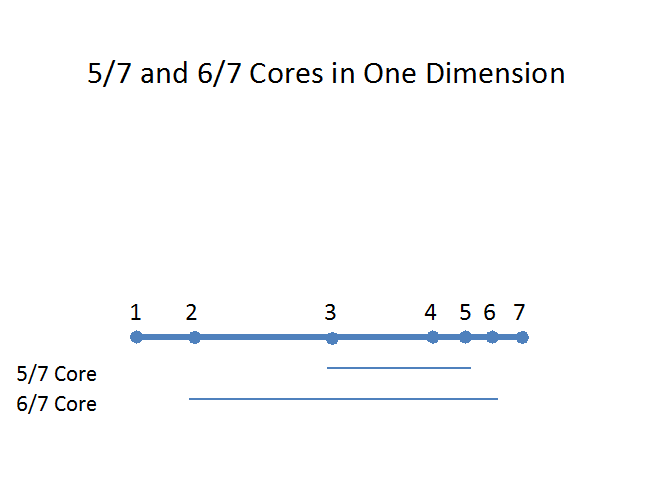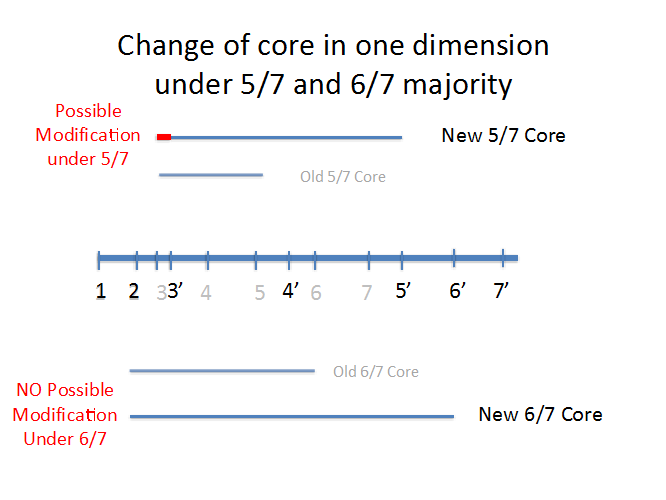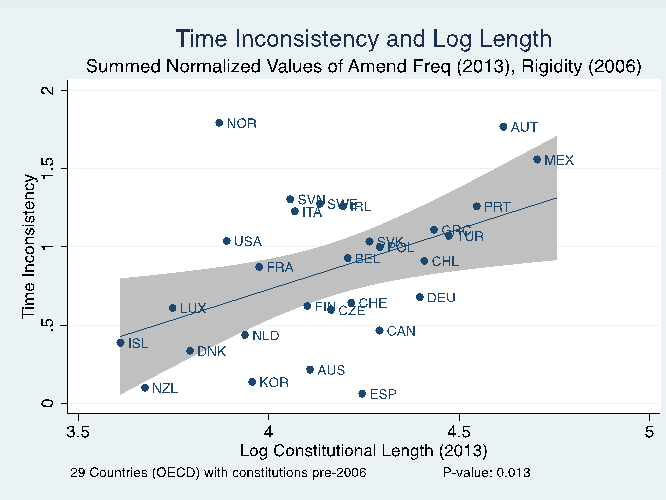Long Constitutions are not Garrulous, they are Restrictive

Constitutions are typically amended after extraordinary procedures. These high hurdles of approval and modification guarantee that the constitution at the moment of adoption or modification is located in the “constitutional core” of a country. The “core” of a political system is a technical term referring to the set of points that cannot be upset by some specified majoritarian procedure. So, the “constitutional core” means the document that cannot be replaced by any other under the existing requirements for constitutional revision.
Let us consider a body that decides by qualified majority rule in one dimension (like a parliament with a single chamber).1 In Figure 1 below, I present a seven-member body that decides by a qualified majority of 5/7 or 6/7. The reader can verify that when the qualified majority increases from 5 to 6 members, the core expands (from the 3-5 segment to the 2-6 segment).
Figure 1. Unicameral Core with 5/7 and 6/7 Majorities

Tsebelis and Nardi (BJPS)2 argue that a constitution will be located inside the core of a political system. Indeed, any proposal outside the core would be defeated by a point inside the core. As for constitutional revisions, Tsebelis and Nardi argue that the only way they become an option is because a point that was inside this core is now located outside. In other words, a constitutional revision can involve only points (and provisions) that used to be centrally located inside the body politic of a country but ceased to occupy such a location, and the new core does not include them anymore.
Figure 2. Change of Core in one Dimension under a 5/7 and 6/7 Majority

This change can occur only under a significant modification of the positions of individual players (or exogenous shocks that make the previous positions no longer tenable). Figure 2 presents such a modification in one dimension to make things clear. The underlying assumption is that a qualified majority in one chamber only is required for the revision.
In the example, out of the 7 members, 5 have shifted and moved (some of them significantly to the right). In particular, players 1 and 2 remained in place, while player 3 moved slightly to the right (from 3 to 3’), player 4 moved by a substantial amount (to position 4’ which is leapfrogging the old player 5), and players 5, 6, and 7 in their new positions (5’, 6’ and 7’) moved outside the whole political space of the past (beyond point 7 of the figure). This is a political change so radical that it is difficult to imagine in any real polity outside a revolution. Yet, the 5/7 core was only slightly modified: player 3 has moved outside the core and player 7 is now within the core. More to the point, it is only if the constitution involved a provision in the (3,3’) area that there are grounds for a constitutional revision if the required constitutional revision majority is 5/7. On the other hand, if the required majority for constitutional revision is 6/7, then there is no possibility for such a modification (despite the significant shift of the public opinion). Then voter 2 will preserve the constitution by voting down the amendment. From the above discussion follows that a constitutional change requires a point of the previous constitutional core (an article or a section of the existing constitution) to be located outside the current constitutional core of the polity.
On the basis of the above analysis, given the large size and the central location of these constitutional cores, it is very likely that the two cores (at time t and t+1) will overlap. Points in the intersection of the two cores cannot be subject of constitutional revisions (by the definition of “core”). The only provisions that could be changed are the ones that belong in the core at time t but not in the core at time t+1, as illustrated with player 3 in Figure 2. Unlike simple legislation that (usually) requires a simple majority in parliament, and can be changed by a different majority (left succeeding right or vice versa), the required constitutional majorities include parts of the previous majorities. Consequently, constitutional revision requires a massive change in the opinions of the political actors.
I call the sum of constitutional rigidity (the difficulty of changing the constitution) and amendment frequency time inconsistency. This variable indicates how frequently the constitution changes despite the fact that it is locked. In Figure 3 below, I show the relationship between the length of the constitution and time inconsistency.
Figure 3. Time inconsistency (i.e. locking and frequency of amendments), as a function of (logged) length of the corresponding constitution

What are the implications of this analysis? Constitutional revisions can occur either because the preferences of political forces changed (in other words, they recognize that they had made a mistake in the original draft) or because external conditions changed significantly such that new provisions are considered necessary (for example, an economic crisis). But why should all these difficulties of locking and unlocking be associated with long constitutions? Figure 3 above provides the answer that length is not an innocuous variable associated just with the number of words. It is a summary indicator of the level of restrictive provisions associated with each item included in the constitution. And it is these restrictions that enter into conflict with an evolving reality which generate the need for change (despite the difficulties of unlocking the constitution).
The focus of constitutional revisions is on prescriptive or proscriptive provisions, not on hortatory or aspirational statements. The very attempt to amend the constitution indicates that the existing constitution had (in the opinion of overwhelming majorities in the country) serious shortcomings, and these shortcomings were experienced and understood as such. This is a fundamental point of the analysis. The frequency of revisions indicates that constitutions are not just garrulous, but also impose objective, negative costs on society. Tsebelis and Nardi (BJPS) connect lengthy constitutions with low GDP per capita, and corruption.
Addapted from: Tsebelis, G., & Nardi, D. J. (2014). A Long Constitution is a (Positively) Bad Constitution: Evidence from OECD Countries. British Journal of Political Science, 1-22.
